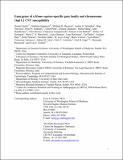Emergence of a Homo sapiens-specific gene family and chromosome 16p11.2 CNV susceptibility
Author(s)
Nuttle, Xander; Giannuzzi, Giuliana; Duyzend, Michael H.; Schraiber, Joshua G.; Narvaiza, Iñigo; Sudmant, Peter H.; Penn, Osnat; Chiatante, Giorgia; Malig, Maika; Huddleston, John; Benner, Chris; Camponeschi, Francesca; Ciofi-Baffoni, Simone; Stessman, Holly A. F.; Marchetto, Maria C. N.; Denman, Laura; Harshman, Lana; Baker, Carl; Raja, Archana; Penewit, Kelsi; Janke, Nicolette; Tang, W. Joyce; Ventura, Mario; Banci, Lucia; Antonacci, Francesca; Akey, Joshua M.; Amemiya, Chris T.; Gage, Fred H.; Reymond, Alexandre; Eichler, Evan E.; Sudmant, Peter; ... Show more Show less
DownloadMain article (2.092Mb)
PUBLISHER_POLICY
Publisher Policy
Article is made available in accordance with the publisher's policy and may be subject to US copyright law. Please refer to the publisher's site for terms of use.
Terms of use
Metadata
Show full item recordAbstract
Genetic differences that specify unique aspects of human evolution have typically been identified by comparative analyses between the genomes of humans and closely related primates, including more recently the genomes of archaic hominins. Not all regions of the genome, however, are equally amenable to such study. Recurrent copy number variation (CNV) at chromosome 16p11.2 accounts for approximately 1% of cases of autism and is mediated by a complex set of segmental duplications, many of which arose recently during human evolution. Here we reconstruct the evolutionary history of the locus and identify bolA family member 2 (BOLA2) as a gene duplicated exclusively in Homo sapiens. We estimate that a 95-kilobase-pair segment containing BOLA2 duplicated across the critical region approximately 282 thousand years ago (ka), one of the latest among a series of genomic changes that dramatically restructured the locus during hominid evolution. All humans examined carried one or more copies of the duplication, which nearly fixed early in the human lineage—a pattern unlikely to have arisen so rapidly in the absence of selection (P < 0.0097). We show that the duplication of BOLA2 led to a novel, human-specific in-frame fusion transcript and that BOLA2 copy number correlates with both RNA expression (r = 0.36) and protein level (r = 0.65), with the greatest expression difference between human and chimpanzee in experimentally derived stem cells. Analyses of 152 patients carrying a chromosome 16p11.2 rearrangement show that more than 96% of breakpoints occur within the H. sapiens-specific duplication. In summary, the duplicative transposition of BOLA2 at the root of the H. sapiens lineage about 282 ka simultaneously increased copy number of a gene associated with iron homeostasis and predisposed our species to recurrent rearrangements associated with disease.
Date issued
2016-08Department
Massachusetts Institute of Technology. Computational and Systems Biology ProgramJournal
Nature
Publisher
Nature Publishing Group
Citation
Nuttle, Xander; Giannuzzi, Giuliana; Duyzend, Michael H.; Schraiber, Joshua G.; Narvaiza, Inigo; Sudmant, Peter H.; Penn, Osnat; et al. “Emergence of a Homo Sapiens-Specific Gene Family and Chromosome 16p11.2 CNV Susceptibility.” Nature 536, no. 7615 (August 3, 2016): 205–209. © 2016 Macmillan Publishers Limited, part of Springer Nature.
Version: Author's final manuscript
ISSN
0028-0836
1476-4687